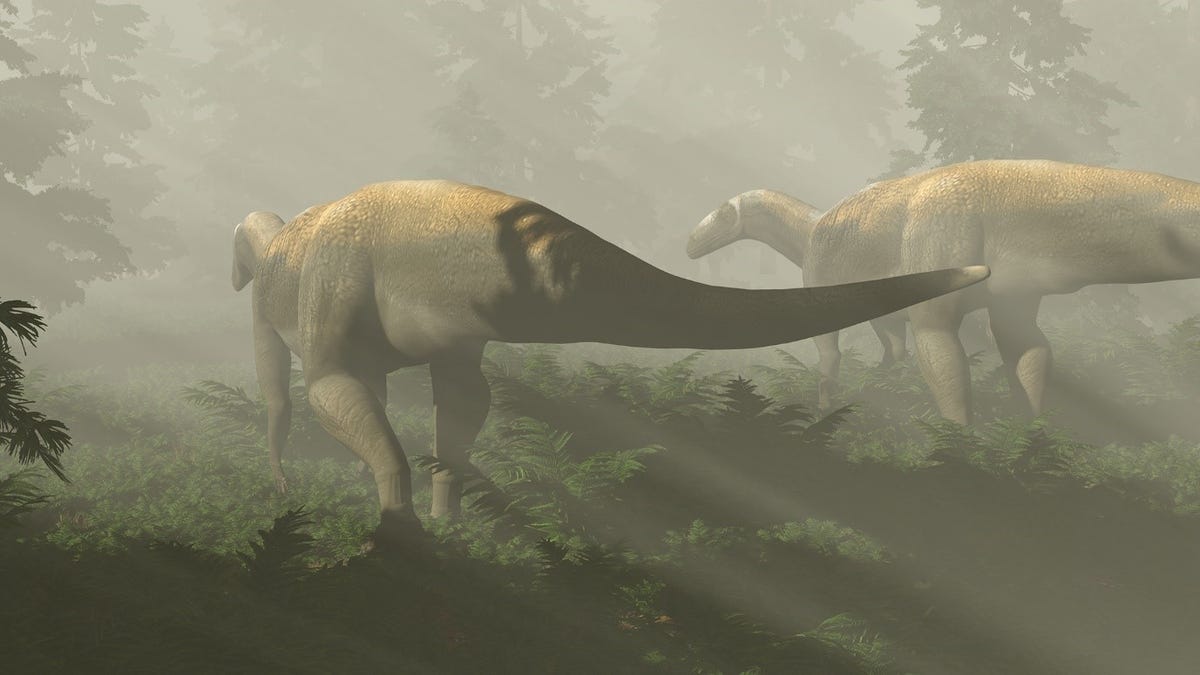'Monster' dinosaur fossil may not belong to vicious raptor-like predator
Scientists thought they found footprints of the Triassic period's "largest meat-eating dinosaur." Nope. The steps belonged to a tender vegetarian.

A reconstruction of the herbivorous dinosaurs, prosauropods, based on 220-million-year-old fossil footprints from Ipswich, Queensland, Australia.
In the 1960s, a crew of Australian coal miners stumbled on an alarming underground sight: dinosaur tracks. The fossilized footprints' general shape eventually led experts to paint the creature responsible for them as a vicious, predatory, "raptor-like" monster.
But a new in-depth analysis, published Thursday in the journal Historical Biology, suggests that inference couldn't have been more wrong. This 220 million-year-old dinosaur from the Triassic period wasn't a threatening beast out for blood.
It was a four-legged, long-necked, cuddly-looking and gentle vegetarian friend.
"The more we looked at the footprint and toe impression shapes and proportions, the less they resembled tracks made by predatory dinosaurs," Anthony Romilio, a paleontologist at The University of Queensland in Australia and lead author of the study, said in a statement.
"This monster dinosaur was definitely a much friendlier plant eater."
An unusual aspect of the miners' discovery -- just west of Brisbane, Australia -- was that the prints weren't located on the floor. They were protruding from stone right above the workers' heads.
3D image of the 220 million-year-old footprint from Ipswich, Queensland.
"It must have been quite a sight for the first miners in the 1960s to see big bird-like footprints jutting down from the ceiling," Romilio said. His team deduced the reason to be that the frolicking animals had stepped in swampy material above the mine.
"After millions of years, the plant material turned into coal which was extracted by the miners to reveal a ceiling of siltstone and sandstone -- complete with the natural casts of dinosaur footprints," Hendrik Klein, co-author and fossil expert from Saurierwelt Paläontologisches Museum in Germany, said in a statement.
Even though the casts were well-preserved and available for analysis, there still existed a discrepancy between what was once thought to be the dinosaur's demeanor and what has been uncovered. The researchers blame it on the lack of technology back in the day; previous examinations only used 2D references of the fossils.
"Unfortunately, most earlier researchers could not directly access the footprint specimen for their study, instead relying on old drawings and photographs that lacked detail," Romilio explained.
His team, instead, re-created the ancient footprints in digital 3D. The tracks, some of which the paper says reached lengths of 18 inches (46 centimeters), turned out to be most consistent with a dinosaur group known as prosauropods. These tender giants, about 4.6 feet (1.4 meters) tall and nearly 20 feet (6 meters) long, were good-natured plant eaters.
Life reconstruction of the gentle 220 million-year-old dinosaur to scale with a 5.6 feet (1.7 meter) tall person.
That's in contrast to the terrifying predators these three-toed marks have long been attributed to: Dinosaurs from the Eubrontes family.
"This idea caused a sensation decades ago because no other meat-eating dinosaur in the world approached that size during the Triassic period," Romilio said. Standing over 6.5 feet (2 meters) tall and feasting on fresh meat, the Eubrontes kin were definitely not hanging in the same grasses as prosauropods. Except, perhaps, to grab dinner.
Although the prehistoric creature has been moved from the guise of flesh-eater to gentle soul, it's footprints are maintained as an important addition to our repertoire of dinosaur knowledge.
"This is still a significant discovery even if it isn't a scary Triassic carnivore," Romilio said. "This is the earliest evidence we have for this type of dinosaur in Australia, marking a 50 million-year gap before the first quadrupedal sauropod fossils known."

